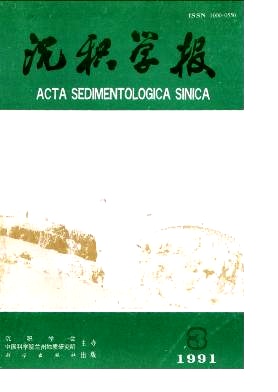Clasolite Tidal Flat Deposits of Gaoshanhe Group in the Southern Margin of the North China Platform
- Received Date: 1989-05-16
- Publish Date: 1991-09-10
Abstract: The strata of Gaoshanhe Group lies in Long County to Luonan County of Shaanxi Province in the Southern Margin of the North China Platform. The total thickness of the deposits reaches to 3989.9 metres, and the clasolite tidal flat deposits are well developed, conglomerate, sandstone, siltstone and argillaceous rock (slate) occupy an important proportion, while a little dolomite. Some typical sedimentary features which reflect their envioronment have been preserved in the tidal flat deposits. The predominant ones are double mud beds, B-C sequence, tidal bedding, herringbone cross-bedding, reactivated surface structure, various shapes of ripples, drying cracks, flattened mud gravels, wormes and their trace fossils and so on. The clasolite tidal flat sedimentary envioronment of the Gaoshanhe Group can be farther divided into three subfacieses, low tidal flat, middle tidal flat and high tidal flat. When sedimentation moved forward to sea, the tidal flats piled up successively, and formed a progradational sequence in which the grain size of sediments diminishes uppwards. In the low tidal flat, the medium-bedded, medium-fine grained quartatic sandstone which have higher maturity and small-scale current cross bedding is deposited in the thick-bedded, medium-grained quartzitic sandstone in tidal under flat which have large scale cross bedding. The flattened mud gravels, herringbone cross-bedding, reactionary surface structure and various ripple shapes can be seen and they are intorgrown. In the midc tidal flat, the dominant kinds of rock are brown-grey thin-medium bedded, fine-grained quartzose sandstone, quartz graywacke, dark grey slate and sand-contained slate. They are thin-interbedded, the flaser beddings, wavy beddings and lenticular beddings are developed. In the high tidal flat, the dominant kinds of rocks are thick-bedded slate, sand-contained slate with a little thin梑edded siltstone and thin-grained quartzose sandstone, the horizontal beddings are developed and drying cracks are very usual. The thickness of a complete tidal flat sedimentary sequence in the region is 2 to 5 metres in general with the average of 3.5 metres. Based on the theory of G. deV. Klein (1970). it can be infered that the old tidal range of the Gaoshanhe stage is maybe about 3.5 metres which is similar to the modern tidal range of the gulf. The region has been considered as a very important sedimentary centre of the North China Platform during the Gaoshanhe stage of Changcheng Period. Under the tectonic setting which descended steadily for long period and was compensated correspondingly, a suit of deposits in which the predominant kinds of rock are clasolite tidal flat ones is developed. We can infer that these kinds of sediments formed basically in the tidal epicontinental sea of the old continental margin.
| Citation: | Li Wenhou. Clasolite Tidal Flat Deposits of Gaoshanhe Group in the Southern Margin of the North China Platform[J]. Acta Sedimentologica Sinica, 1991, 9(3): 98-105. |






 DownLoad:
DownLoad: